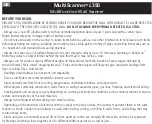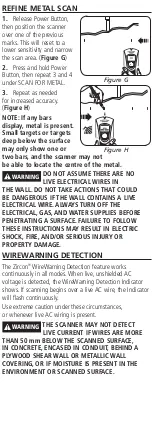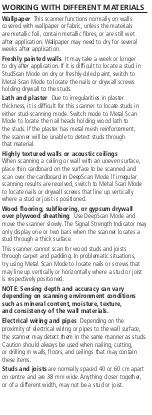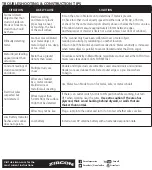
DeepScan
®
Metal Scan
StudScan
SpotLite
®
Pointer
Mode Selector
Switch
Battery
Door Tab
ACT
™
(Auto
Correcting
Technology)
Indicator
Signal
Strength
Indicator
Ergonomic Rubber Grip
Power Button
StudScan
Mode
Indicator
Stud EDGE / CENTER Indicators
Metal Scan
Mode Indicator
Target
Indicator Bars
Low
Battery
Indicator
DeepScan
®
Mode
Indicator
BEFORE YOU BEGIN
ZIRCON
®
STUD FINDERS WORK BY SENSING DENSITY CHANGES BEHIND THE WALL. OTHER OBJECTS CAN BE DETECTED
ESPECIALLY IF THEY ARE VERY CLOSE TO THE WALL.
DO NOT ASSUME EVERYTHING DETECTED IS A STUD.
- Always use a new 9V alkaline battery with an extended expiration date at least 3 years beyond the current date.
Match battery direction to image inside of battery cavity.
- Do not rely exclusively on the scanner to locate items behind a surface. Use other information to help locate such items
before penetrating the surface, including construction plans, visible points of entry of pipes and wiring into walls such as
in a basement, and standard stud-spacing practices.
- Always start your scan in StudScan Mode which scans through surfaces up to 19 mm deep. Scanning in DeepScan
®
Mode may detect an object further behind the wall that may or may not be a stud.
- Always scan for studs at several different heights on the wall and mark the location of every target indicated by
the stud finder. This is called “mapping the wall.” Pipes and other objects will likely not give consistent readings from
floor to ceiling, like a stud would.
- Readings should always be consistent and repeatable.
- Zircon stud finders are recommended for interior use only.
- Studs normally run from floor to ceiling, except above and below windows, and above doors.
- Other objects commonly contained in walls, floors, or ceilings are water pipes, gas lines, firestops, and electrical wiring.
- Sensing depth and accuracy can vary depending on scanning environment conditions such as mineral content, moisture,
texture and consistency of the wall materials.
- Always turn off power when working near electrical wires.
- Depending on the proximity of electrical wiring or pipes to the wall surface, the scanner may detect them in the same
manner as studs. Caution should always be used when nailing, cutting, or drilling in walls, floors, and ceilings that may
contain these items.
- Studs and joists are normally spaced 40 or 60 cm apart on centre, are normally 38 mm wide, and may be separated
by firestops. Anything closer together, or of a different width, may not be a stud or joist.
MultiScanner
®
L350
Multifunction Wall Scanner
TROUBLESHOOTING & CONSTRUCTION TIPS
SITUATION
LIKELY CAUSE
SOLUTION
Scanner detects
objects other than
studs in StudScan
Mode or finds more
studs than should
be there.
Electrical wiring
and metal or plastic
pipes may be near,
or touching, the back
of the wall surface.
• Scan the area in Metal Scan to determine if metal is present.
• Check for other studs equally spaced to either side at 30, 40, or 60 cm,
or check for the same stud at spots directly above or below the first scan area.
• Standard studs measure approximately 38 mm between edges.
Anything larger or smaller is likely not a stud (unless near door or window).
Difficulty detecting
metal.
Scanner was calibrated
over metal object, or
metal object is too deep
or too small.
• The scanner may have been calibrated over a metal object,
reducing sensitivity. Try calibrating in another location.
• Scan in both horizontal and vertical directions. Metal sensitivity is increased
when metal object is parallel to sensor (located under the Zircon Logo).
Metal object reading
appears wider than
actual size.
Metal has a greater
density than wood.
To reduce sensitivity in Metal Mode, recalibrate scanner over either of first two
marks (see steps under SCAN FOR METAL).
Constant readings of
studs near windows
and doors.
Multiple studs are
in use.
Double and triple studs are sometimes used around doors and windows.
Headers are used above them. Detect outer edges so you know where
to begin.
Electrical wires
suspected but
not detected.
Wires are shielded
by a metal conduit,
braided wire or
metallic wall covering.
Use Metal Scan Mode to scan for metal, wire, or metal conduit.
Wires deeper than
50 mm from the surface
might not be detected.
If there is an outlet switch, turn it to ON position while scanning, but turn
OFF when working near the wires.
Use extra caution if the area has
plywood, thick wood backing behind drywall, or walls that are
thicker than normal.
Wires may not be live.
Plug a lamp into the outlet and turn it on to test whether wires are live.
Low Battery Indicator
flashes and scanner
does not operate.
Low battery.
Install a new 9V alkaline battery with an extended expiration date.
GB
WireWarning
®
Detection
Indicator
Backlit LCD Display
3 scanning modes:
• StudScan
locates centre and edges of stud (wood or
metal) up to 19 mm deep
• DeepScan
locates centre and edges of stud up to
38 mm deep
• Metal Scan
locates ferrous (magnetic) metal, such
as steel, up to 75 mm deep, and non-ferrous (non-
magnetic) metal, such as copper, up to 38 mm deep
WireWarning
Detection
automatically detects and
alerts for live, unshielded AC (alternating current) wires up
to 50 mm deep in all modes.
INSTALL 9-VOLT BATTERY
Always use a new 9V alkaline
battery
with an extended expiration date at
least 3 years beyond the current date.
Match battery direction to image
inside of battery cavity.
WARNING
Do not rely exclusively on the tool
to locate items behind a surface.
Use other information to help locate items before
penetrating the surface, including construction
plans, visible points of entry of pipes and wiring
into walls such as in a basement, and standard
stud-spacing practices.
SELECT MODE / POWER UP
Move Mode Selector Switch to desired mode:
StudScan,
DeepScan,
or
Metal Scan.
To activate scanner, press and hold Power Button.
If Power Button is not pressed & held, unit shuts off.
REFINE METAL SCAN
1.
Release Power Button,
then position the scanner
over one of the previous
marks. This will reset to a
lower sensitivity and narrow
the scan area. (
Figure G
)
2.
Press and hold Power
Button, then repeat 3 and 4
under SCAN FOR METAL.
3.
Repeat as needed
for increased accuracy.
(
Figure H
)
NOTE: If any bars
display, metal is present.
Small targets or targets
deep below the surface
may only show one or
two bars, and the scanner may not
be able to locate the centre of the metal.
WARNING
DO NOT ASSUME THERE ARE NO
LIVE ELECTRICAL WIRES IN
THE WALL. DO NOT TAKE ACTIONS THAT COULD
BE DANGEROUS IF THE WALL CONTAINS A LIVE
ELECTRICAL WIRE. ALWAYS TURN OFF THE
ELECTRICAL, GAS, AND WATER SUPPLIES BEFORE
PENETRATING A SURFACE. FAILURE TO FOLLOW
THESE INSTRUCTIONS MAY RESULT IN ELECTRIC
SHOCK, FIRE, AND/OR SERIOUS INJURY OR
PROPERTY DAMAGE.
WIREWARNING DETECTION
The Zircon
®
WireWarning Detection feature works
continuously in all modes. When live, unshielded AC
voltage is detected, the WireWarning Detection Indicator
shows. If scanning begins over a live AC wire, the Indicator
will flash continuously.
Use extreme caution under these circumstances,
or whenever live AC wiring is present.
WARNING
THE SCANNER MAY NOT DETECT
LIVE CURRENT IF WIRES ARE MORE
THAN 50 mm BELOW THE SCANNED SURFACE,
IN CONCRETE, ENCASED IN CONDUIT, BEHIND A
PLYWOOD SHEAR WALL OR METALLIC WALL
COVERING, OR IF MOISTURE IS PRESENT IN THE
ENVIRONMENT OR SCANNED SURFACE.
FIND A STUD
For best results, hold the scanner as
shown (
Figure A
) and move slowly
when scanning.
Do not touch
the surface during calibration
or scan.
1.
Set mode to StudScan.
2.
Hold scanner flat against wall,
then press and hold Power Button.
In 1 – 2 seconds, the unit will
calibrate. A short beep confirms
that calibration is complete.
DO NOT MOVE SCANNER
DURING CALIBRATION.
3.
While holding down the Power
Button, slide the scanner slowly
along the wall. When scanner finds
the edge of a stud, EDGE displays.
(
Figure B
)
4.
Continue sliding. When scanner
finds the centre of a stud, CENTER
displays, light illuminates, 3 bars
show signal strength, and a buzzer
sounds. (
Figure C
)
NOTE: If only two signal bars
show (Figure D), stud may be
too deep. Select DeepScan Mode,
and repeat scan.
Scanner automatically recalibrates
when in use. If arrows appear on
the display (
Figure E
), the scanner
was calibrated too close to a stud,
then moved away. This is
ACT (Auto
Correcting Technology)
.
SCAN IN DEEPSCAN MODE
DeepScan Mode can detect studs up to 38 mm deep.
To scan for deeper studs, or for use with thicker walls:
1.
Set mode to DeepScan.
2.
Repeat steps 2 – 4 under FIND A STUD.
SCAN FOR METAL
Use Metal Scan Mode to determine if the stud found is
wood, or a metal stud or pipe.
1.
Set mode to Metal Scan.
2.
For maximum sensitivity, press and hold Power Button.
Hold the scanner away from the surface until a short beep
confirms calibration is complete, then place against the
surface to be scanned.
3.
While continuing to
hold Power Button, slide the
scanner slowly against the
wall.
Mark the spot
where
the most middle bars display.
For a strong read, the scanner
will light up and a steady
beep will sound. (
Figure F
)
4.
Continue sliding in same direction until bars reduce,
then reverse direction.
Mark the spot
where the display
bars peak. The midpoint between the two marks is the
location of the metal object.
NOTE: If the unit indicates a large area of metal,
refine the scan to more accurately find the centre.
WORKING WITH DIFFERENT MATERIALS
Wallpaper
This scanner functions normally on walls
covered with wallpaper or fabric, unless the materials
are metallic foil, contain metallic fibres, or are still wet
after application. Wallpaper may need to dry for several
weeks after application.
Freshly painted walls
It may take a week or longer
to dry after application. If it is difficult to locate a stud in
StudScan Mode on dry or freshly-dried paint, switch to
Metal Scan Mode to locate the nails or drywall screws
holding drywall to the studs.
Lath and plaster
Due to irregularities in plaster
thickness, it is difficult for this scanner to locate studs in
either stud-scanning mode. Switch mode to Metal Scan
Mode to locate the nail heads holding wood lath to
the studs. If the plaster has metal mesh reinforcement,
the scanner will be unable to detect studs through
that material.
Highly textured walls or acoustic ceilings
When scanning a ceiling or wall with an uneven surface,
place thin cardboard on the surface to be scanned and
scan over the cardboard in DeepScan Mode. If irregular
scanning results are received, switch to Metal Scan Mode
to locate nails or drywall screws that line up vertically
where a stud or joist is positioned.
Wood flooring, subflooring, or gypsum drywall
over plywood sheathing
Use DeepScan Mode and
move the scanner slowly. The Signal Strength Indicator may
only display one or two bars when the scanner locates a
stud through a thick surface.
This scanner cannot scan for wood studs and joists
through carpet and padding. In problematic situations,
try using Metal Scan Mode to locate nails or screws that
may line up vertically or horizontally where a stud or joist
is respectively positioned.
NOTE: Sensing depth and accuracy can vary
depending on scanning environment conditions
such as mineral content, moisture, texture,
and consistency of the wall materials.
Electrical wiring and pipes
Depending on the
proximity of electrical wiring or pipes to the wall surface,
the scanner may detect them in the same manner as studs.
Caution should always be used when nailing, cutting,
or drilling in walls, floors, and ceilings that may contain
these items.
Studs and joists
are normally spaced 40 or 60 cm apart
on centre and are 38 mm wide. Anything closer together,
or of a different width, may not be a stud or joist.
DeepScan
®
Metal Scan
StudScan
Figure F
DeepScan®
Metal Scan
StudScan
Figure G
DeepScan
®
Metal Scan
StudScan
Figure H
Figure B
Figure A
Figure C
Figure D
Figure E
Visit uk.zircon.com for the
most current instructions.
ZirconCorporation
ZirconTV
ZirconTools
|
ZirconToolPro
ZirconTools
LIMITED TWO-YEAR WARRANTY
Zircon Corporation (“Zircon”) warrants to the
original purchaser (or original user by gift) that this
product will be free from defects in materials and
workmanship for two years from date of purchase.
This warranty is limited to the electronic circuitry of
the product, and specifically excludes consumable
parts, including batteries, and software, even if
packaged with the product. Defects caused by abuse,
modification, handling contrary to these instructions,
other unreasonable use, or neglect are not covered
under this warranty. No liability is accepted for
normal wear and tear and minor defects which do not
detract from the function of the product. This Limited
Warranty is in addition to the statutory rights to
which purchaser is entitled and which are not limited
by this warranty.
THIS LIMITED WARRANTY IS IN LIEU OF ALL OTHER
WARRANTIES, EXPRESS OR IMPLIED, INCLUDING THE
IMPLIED WARRANTIES OF MERCHANTABILITY AND
FITNESS FOR A PARTICULAR PURPOSE. IF ANY IMPLIED
WARRANTIES ARE APPLICABLE, THEY ARE LIMITED TO
THE TWO-YEAR PERIOD DEFINED ABOVE. IN NO EVENT
WILL ZIRCON BE LIABLE FOR ANY SPECIAL, INDIRECT,
INCIDENTAL OR CONSEQUENTIAL DAMAGES RESULTING
FROM POSSESSION, USE, OR MALFUNCTION OF THIS
PRODUCT. NO OTHER REPRESENTATIONS OR CLAIMS OF
A SIMILAR NATURE WILL BIND OR OBLIGATE ZIRCON.
Any in-warranty defective product returned to the
place of purchase with original proof of purchase
will be replaced or purchase price refunded at
retailer’s option. This Limited Warranty applies only
to products purchased within the European Economic
Area and United Kingdom. For warranties applicable to
Zircon products purchased in other geographical areas,
see www.zircon.com/warranty.
For questions about this warranty or
Zircon products, contact:
Customer Service:
+1-800-245-9265 or +1-408-963-4550
Monday–Friday, 8:00 a.m. to 5:00 p.m. PST
www.zircon.com • [email protected]
©2019 Zircon Corporation • P/N 68682 • Rev
C
0
8
/19
ACT, DeepScan, MultiScanner, SpotLite, WireWarning,
and Zircon are registered trademarks or trademarks
of Zircon Corporation.







